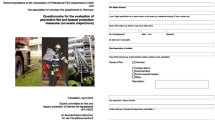Abstract
Hazard identification is an important basis for the design of coal mine safety signs. This paper analyses the coal face hazard checklists in a large state-owned coal mine enterprise in China from January 2015 to December 2015. The conclusion is hazard occurring most frequently on top five are liquid leakage, spray unopened, belt deviation, littering, cylinder distance too close. According to the conclusion, the paper designed five safety signs which are cylinders must have a sufficient distance, be careful not to let the belt running deviation, prohibit littering, precaution the liquid leakage and must open spray using computer graphics software. Using information formula to calculate five disigned safety signs of design, it is found that no ambiguity for the sign of must be sprayed marks. Information of sufficient distance between cylinders sign and caution liquid leakage sign is between 0 and 1, which are acceptable. Information of no littering sign and warning the belt deviation sign is between 1 and 2, which means there are too many ambiguities for the signs and need to be redesigned.

Similar content being viewed by others
References
Tom, S. (2013). The evolution of safety signs. Occupational Health and Safety, 82(2), 38–40.
Matthews, B., Andronaco, R., & Adams, A. (2014). Warning signs at beaches: Do they work? Safety Science, 62(2), 312–318.
Riley, D. (2014). Mental models in warnings message design: A review and two case studies. Safety Science, 61(1), 11–20.
Borade, et al. (2008). Hazard perception based on safety words and colors: An Indian perspective. International Journal of Occupational Safety and Ergonomics (JOSE), 14(4), 407–416.
David Leonard, S., & Karnes, E. W. (2000). Socio-environmental effects on warnings. International Journal of Industrial Ergonomics, 25(1), 11–18.
Dokas, I. M., Feehan, J., & Imran, S. (2013). EWaSAP: An early warning sign identification approach based on a systemic hazard analysis. Safety Science, 47(4), 11–26.
Kalsher, M. J. (2014). Special issue: Risk communication and warnings. Safety Science, 61(8), 1–2.
McLaughlin, A. C., & Mayhorn, C. B. (2014). Designing effective risk communications for older adults. Safety Science, 61(1), 59–65.
Laughery, K. R., & Wogalter, M. S. (2014). A three-stage model summarizes product warning and environmental sign research. Risk Communication and Warnings, 61(1), 3–10.
Waterson, P., Pilcher, C., Evans, S., et al. (2012). Developing safety signs for children on board trains. Applied Ergonomics, 43(1), 254–265.
Ng, A. Y., & Chan, A. S. (2008). The effects of driver factors and sign design features on the comprehensibility of traffic signs. Journal of Safety Research, 39(3), 321–328.
Tey, L., Wallis, G., Cloete, S., et al. (2013). Evaluating driver behavior toward innovative warning devices at railway level crossings using a driving simulator. Journal of Transportation Safety & Security, 5(2), 118–130.
Haas, E. C., & van Erp, J. B. F. (2014). Multimodal warnings to enhance risk communication and safety. Safety Science, 61(1), 29–35.
Duarte, E., Rebelo, F., Teles, J., et al. (2014). Safety sign comprehension by students, adult workers and disabled persons with cerebral palsy. Safety Science, 61(1), 175–186.
Acknowledgements
This paper is funded by National Natural Science Foundation of China—Study on the improvement of safety culture concept, elements and quantitative measurement method (Project Number: 51504260).
Author information
Authors and Affiliations
Corresponding author
Rights and permissions
About this article
Cite this article
Jiang, W. Effect of Hazard Identification and Information Amount Calculation in Coal Mine Safety Signs Design. Wireless Pers Commun 103, 437–445 (2018). https://doi.org/10.1007/s11277-018-5453-7
Published:
Issue Date:
DOI: https://doi.org/10.1007/s11277-018-5453-7




